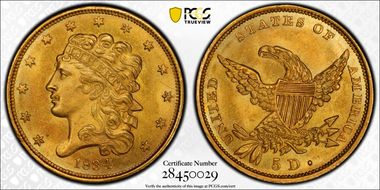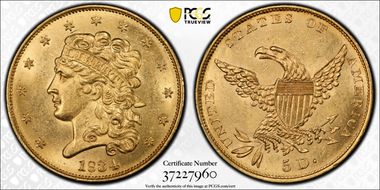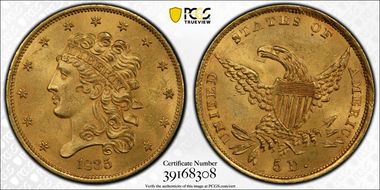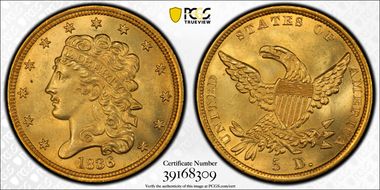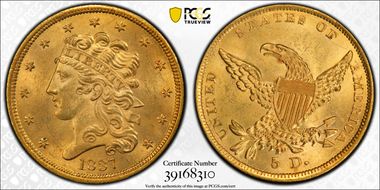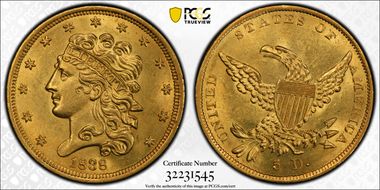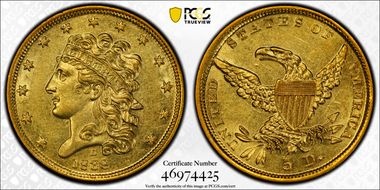JD's Classic Head $5 的钱币相册
CAC, HM-4, R-5+. Obverse 3: Script 8, the 3 and 4 are distant in the date (same as HM-3). Reverse B: 5 left of arrow, middle arrow shaft missing left of the eagle’s claw (same as HM-2). This is the finest known HM-4, the rarest die pairing in 1834. It is over four times scarcer than the Crosslet 4. On this example, the strike is extremely strong, showing only minor weakness on stars three through five and the BE in the Liberty Band. The luster is frosty, displaying a full cartwheel effect. Brilliant orange and bluish toning are highlighted throughout. The obverse has a die crack running from the eye to the back of the mouth and the reverse has a die crack running along the lower portion of NITED in UNITED. A stunning example of a Classic Head Half Eagle. Purchased from Crescent City Numismatics.
CAC, HM-9, R-4. Obverse 5: Script 8 and the well-known Crosslet 4 in the date; this obverse is unique. Reverse D: There is no tongue, no berry and the 5 is directly below the arrow feather. This example is the first of only two UNC coins verified by CAC for this variety. It has beautiful, original “skin” and is highly reflective with satiny, semi-prooflike luster. The strike is extremely strong for the type; the color is yellow gold. Reverse D exhibits a distinct die clash within the vertical shield stripes. It is the ERT and part of Y from the obverse of 1835 HM-1. 1835 HM-1 was minted prior to the 1834 Crosslet 4. Purchased from Crescent City Numismatics; ex: Bowers and Ruddy 10/77 (Fairfield Collection): 1770.
CAC, HM-8, R-3+. Obverse 3 is the same die as HM-7. Reverse A is the same die as HM-4 and HM-6 in 1835 and HM-1, HM-5, and HM-8 in 1834. Tied for finest known at PCGS (13 MS64) and CAC (3 MS64). This is the third most common 1835 die pairing but there are still only 200 suspected survivors. Two of the MS64 1835 half eagles were stuck from these dies; the current coin and the Pogue-Haynor example which sold in September 2022. This well stuck example is green gold with pleasing cartwheel luster. Though well struck, the reverse die is now showing a great deal of deterioration. There are many die cracks, noticeable along the bottom of many letters and from the wing tips to the rim. The right side of the N in UNITED and the top of the first S in STATES are filled in. Purchased from Crescent City Numismatics.
HM-6, R-3, POGUE. Obverse 5: Double forelock, Tall 1 and high, R in LIBERTY is high. Reverse I: Berry with stem, very wide 5 D, O larger than F. A substantial mintage of 553,147 Classic Head half eagles was produced in 1836, with nine different die varieties known for the date. Smooth satiny luster evenly coats both sides, each a light apricot gold. Devices on obverse and reverse are nicely struck, lending further appeal to the supremely attractive and very frosty surfaces. Purchased from Heritage; ex: Stack’s Bowers 5/16: 4053 (Pogue Collection).
CAC, HM-2, R-3+. Obverse 2: The only obverse of the issue with both a single forelock curl and block 8 in the date: this obverse is unique. Reverse L: The middle arrow shaft is broken within the eagle's talon, the only reverse of the issue with this feature. Reverse L is the same as 1838 HM-1. 1837 had the lowest P-mint mintage in the Classic Head Half Eagle series; the HM-2 die pairing is the most common of the three pairings that year. On this example the striking details are complete throughout. The mint luster is abundant and shows a bright, frosted sheen on orange gold surfaces. There are a few insignificant luster grazes on the obverse and a light alloy spot below the eagle's beak on the reverse. Purchased from Crescent City Numismatics.
CAC, HM-1, R-3. Obverse 1: Tall curved serif on 1, center dot in ear; this obverse is unique. Reverse L is the same die as HM-2 in 1837. Beaming, satiny mint luster blooms with a vivid brilliance on both sides. Boldly struck up on the obverse and reverse, the details are crisp and show impressive frost on the devices. There is a clash mark on the reverse in the eagle’s mouth and below the beak. Legend Auctions 10/20: 378.
HM-1, late die state, R-4+, Haynor. Obverse 1: There is only one obverse die for the ’38-C. Reverse P: Leaves 1 and 2 are far from the U in UNITED; this reverse is unique. The underlying color is green-gold but there is some reddish-russet build up within the protected areas of Liberty's portrait, as well as in isolated peripheral areas on both sides. This is a late die state example of the HM-1 die pairing where extensive die lapping has removed the berry and the connection between the stems of the leaves and the eagle’s leg. Stack’s Bowers 8/2022: 5054 (Daryl Haynor’s The Virginian Collection); ex: Heritage 1/08: 3162.
HM -1, R-3. Obverse 1, Reverse R: There is only one die pair known for the 1838-D half eagle; both the obverse and reverse are unique dies. The most recent estimate is that only 10-12 examples are known in mint state. The strike on this yellow gold example is exceptional; the only weakness is on the peripheral stars where the radial lines are generally missing; this probably resulted from excessive die polishing. The texture is a subtle frost with prooflike characteristics, particularly on the reverse. There is some die rust evident with raised “bumps” in front of the top of the throat.




















